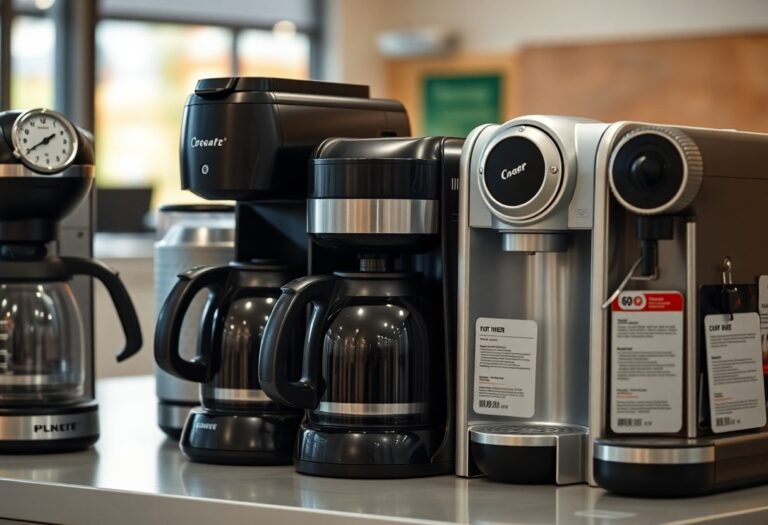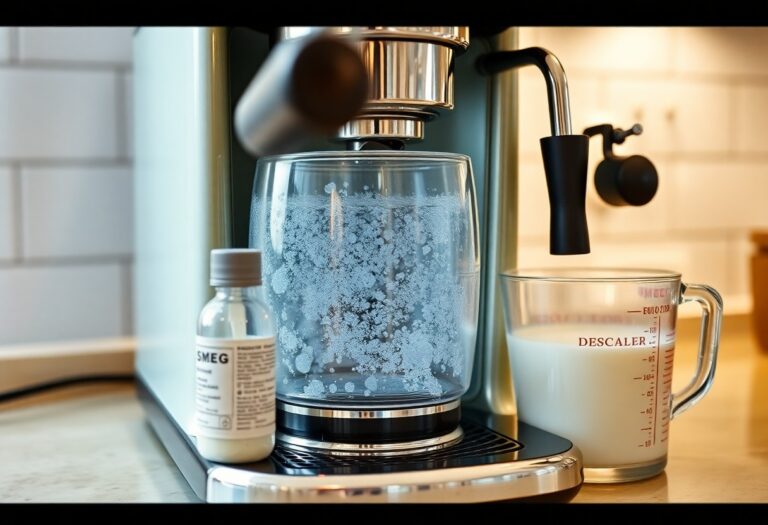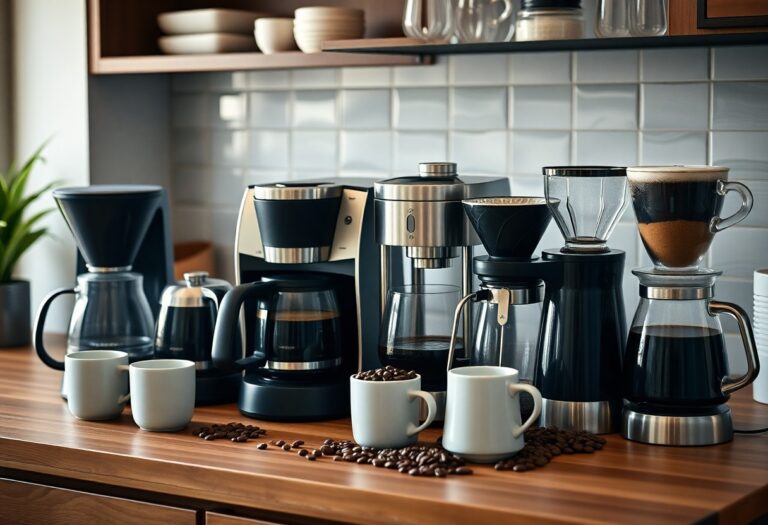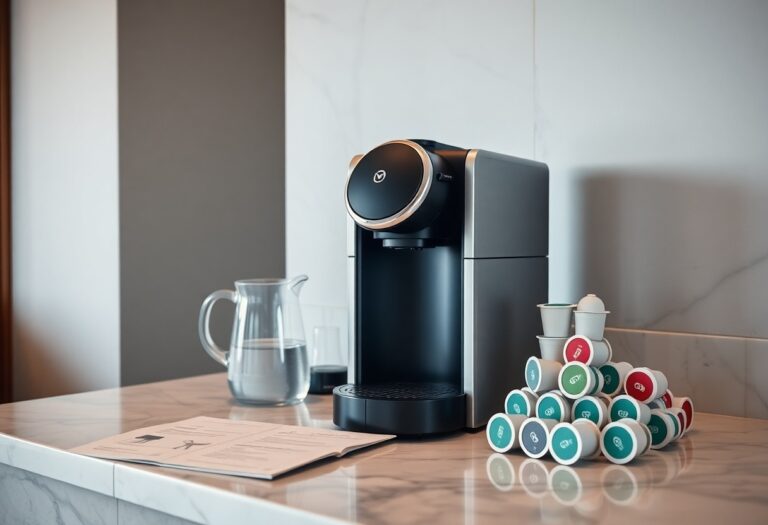What is the Best Coffee Filter Machine – Drip Brewing Leader
It’s necessary to choose the right coffee filter machine for your home brewing needs, as the quality of your coffee largely depends on it. You want a machine that not only excels in brewing but also offers convenience and flavor without the hassle of complicated setups. This guide will help you explore the top drip brewing leaders in the market, focusing on their features, ease of use, and cost-effectiveness, allowing you to make an informed decision that enhances your daily coffee ritual.

Key Takeaways:
- Drip coffee machines are known for their convenience and ability to brew large quantities in one go, making them popular for home use.
- Look for machines with adjustable brew strength settings to customize the flavor of your coffee according to your preference.
- Consider models with programmable features, allowing you to set a timer for brewing coffee ahead of time.
- Quality coffee filters, such as paper or metal, play a significant role in the final taste; some machines come with built-in filter baskets that make the process seamless.
- Read customer reviews and expert ratings to find a reliable machine that fits your brewing needs and budget.
The Mechanics of Drip Brewing: How Coffee Filter Machines Work
Drip brewing, powered by coffee filter machines, relies on a simple yet effective mechanism that consists of heating water, allowing it to flow through coffee grounds, and then collecting the brewed coffee. The machine heats the water to the optimum temperature, which typically ranges between 195°F to 205°F, and directs it through a filter containing ground coffee. The brewed coffee then drips into a carafe, providing you with a hot beverage. This method ensures an even extraction, bringing out the rich flavors and aromas of your coffee.
The Role of Water Temperature and Flow Rate
| Water Temperature | Optimal range is 195°F to 205°F for best flavor extraction. |
|---|---|
| Flow Rate | Controlled flow allows for uniform saturation of coffee grounds, enhancing taste. |
Understanding the Brewing Cycle: From Grind to Brew
The brewing cycle encompasses several stages, beginning with grinding the coffee beans to your desired consistency. Coarsely ground coffee is ideal for a sluggish brew, enabling a rich extraction, while finely ground coffee works well for rapid brewing. After grinding, the coffee is placed in the filter basket, and as the machine heats the water, it is dispersed over the grounds. This process, known as percolation, activates the coffee, releasing flavors and aromas into the brewed liquid.
This cycle highlights the importance of timing and technique. For example, approximately 5 to 6 minutes is ideal for brewing a standard pot of coffee. During this time, the water must flow evenly over the coffee grounds to fully extract the flavors. Your choice of grind size and adequate coffee-to-water ratio directly influences the final strength and flavor of the cup. Careful monitoring of these variables can significantly enhance your home brewing experience, bringing you that perfect cup of coffee tailored to your taste preference.
Key Features of Top Coffee Filter Machines
Understanding the imperative features that define the best coffee filter machines can significantly impact your brewing experience. Look for machines that offer a balance of convenience, efficiency, and quality. Below are key features to consider:
- Programmability: Schedule brewing times for fresh coffee.
- Brewing Capacity: Choose sizes that fit your household or office needs.
- Material Quality: Durable options available in plastic or stainless steel.
- Temperature Control: Ensure optimal extraction by adjusting brew temperature.
- Ease of Cleaning: Simple disassembly and dishwasher-safe components.
Perceiving these features clearly can help you choose a machine that upgrades your coffee routine.
Material Quality: Plastic vs. Stainless Steel
Your choice between plastic and stainless steel in coffee filter machines affects both durability and taste. While plastic components are often lighter and less expensive, they may absorb odors over time, which can impact your coffee flavor. In contrast, stainless steel machines boast longevity and a sleek design, resisting staining and producing cleaner, untainted brews.
Programmable Settings: Convenience and Customization
Programmable settings allow you to customize your brew experience, taking convenience to a new level. Having the ability to set your machine to brew at specific times means you can wake up to a fresh pot of coffee without lifting a finger.
With many models offering options such as strength selection, brew size, and even the temperature of the water, you can create a cup that caters to your taste. Some machines sync with smart devices, enabling remote control of brewing, which suits your busy lifestyle perfectly. Utilizing programmable settings brings a level of sophistication and flexibility that ensures your perfect cup of coffee is always ready when you are.
Brewing Capacity: Finding the Right Size for You
Choosing the right brewing capacity involves assessing both your household size and coffee consumption habits. If you typically brew for one or two people, a compact model may be sufficient. On the other hand, larger machines suited for families or frequent entertainers often hold 10-12 cups, ensuring everyone gets their fix.
Analyzing your typical coffee intake can lead you to the ideal size machine. For instance, if you host guests regularly or enjoy multiple cups throughout the day, a larger capacity model can save you time and effort. The right brewing capacity not only enhances convenience but also eliminates waste, keeping your coffee experience enjoyable and efficient.
The Taste Test: Evaluating Flavor Profiles
To determine the best coffee filter machine, conducting a taste test is important. Flavor profiles can vary dramatically based on brewing methods and coffee quality. Pay attention to attributes like acidity, sweetness, body, and aftertaste when sampling different brews. Armed with your own taste buds, you can identify which machines bring out the best flavors in your favorite coffee. For a more detailed discussion on current options, check out the Best Drip Coffee Makers On The Market Right Now!
Filter Types: Paper vs. Metal and Their Impact on Flavor
The type of filter you use can significantly influence the flavor of your coffee. Paper filters tend to trap oils, leading to a cleaner taste, while metal filters allow for more oils to pass through, resulting in a fuller body and richness. Here is a comparison of filter types:
| Filter Type | Impact on Flavor |
|---|---|
| Paper | Produces a clean and crisp cup, emphasizing acidity. |
| Metal | Yields a fuller-bodied cup with more robust flavors. |
| Reusable | Eco-friendly but may alter taste due to trapped coffee oils. |
| Unbleached | Retains some oils, offering a balanced flavor. |
| Bleached | Generally perceived as tasteless; minimal impact on the flavor profile. |
Any choice of filter can alter your coffee’s flavor profile, so consider what attributes appeal to your palate most when selecting the ideal filter for your brewing process.
Brewing Techniques: Consistency and Control for the Perfect Cup
Achieving the perfect cup of coffee hinges on consistent brewing techniques. Each step, from the coffee-to-water ratio to exact water temperature, plays a pivotal role in your coffee’s final taste. Machines that offer programmable settings allow you to maintain control over variables such as brew time and water dispersion. With tools like a scale to measure coffee, a thermometer for water temperature, and a grinder for consistent particle size, you can replicate successful brews that suit your preferences perfectly.
Diving deeper into brewing techniques reveals that precision is paramount. Aim for a ratio of about 1:15 coffee to water for a balanced brew, adjusting slightly depending on the roast type. Water temperature should ideally hover between 195°F and 205°F, as temperatures outside this range can lead to under-extraction or scorched flavors. Exploring different brewing times can also yield unique flavor profiles; for instance, a longer brewing duration can accentuate sweetness while shorter times may bring out a bright acidity. Careful attention to these details not only ensures a dependable cup of coffee but also elevates your home brewing experience.
The Cost Factor: Balancing Budget and Quality
Finding the best coffee filter machine involves evaluating the cost against the quality you receive. While a lower price may initially seem appealing, investing in a high-quality machine can yield superior flavor and consistent performance, ultimately saving you money in the long run. For valuable insights into coffee machines, check out the Counter Culture Coffee Staff Recommendations, which can guide your purchasing decisions.
Initial Investment vs. Long-Term Savings
The initial price tag of your coffee filter machine can range widely, from budget-friendly options under $50 to premium models exceeding $300. While you may hesitate to spend more upfront, quality machines often exhibit durability and energy efficiency, translating to lower maintenance costs and longer lifespans. Over time, a slightly pricier machine can prove more economical through durability and reduced need for replacements.
Maintenance Costs: Understanding What to Expect
When dicking out your coffee filter machine, consider the ongoing maintenance costs associated with regular use. Filter replacements, water descaling solutions, and occasional servicing can add up. Many higher-end machines require specialized components, but might also boast easier cleaning processes that could save you time and effort over months of ownership. Familiarize yourself with the specific maintenance requirements per model to avoid any unpleasant surprises down the line.
Additionally, keeping your coffee filter machine in optimal condition may necessitate periodic purchases like descaling solutions or new filters. For instance, brands like Bonavita or Technivorm offer replacement filters that can cost anywhere from $10 to $30 per box, depending on where you buy them. Evaluating these aspects ensures you’ll not only enjoy great coffee but also manage costs effectively over time. Regular cleaning and proper care can help minimize maintenance needs, so consider how much time and effort you’re willing to invest in maintaining your coffee machine’s performance.

Consumer Insights: What Real Users Are Saying
Real users often highlight the convenience and flavor consistency of drip brewing machines, with many reporting their satisfaction regarding ease of use and minimal cleanup. Feedback points to a preference for models that maintain the optimal brewing temperature and provide a programmable feature for busy mornings. Some buyers, however, express concerns over the longevity of certain brands, suggesting that while performance may be superb initially, durability varies based on usage frequency and maintenance. Overall, consumer insights emphasize the balance between functionality and reliability.
Top Brands Reviewed: Strengths and Weaknesses
Popular brands in the coffee filter machine market, such as Braun, Cuisinart, and Bonavita, exhibit distinct strengths and weaknesses. Braun machines are praised for their sleek design and ease of use, while Cuisinart models often come with advanced features but may require more maintenance. Bonavita is recognized for excellent coffee extraction, though some users cite issues with noise and heating time. These insights can guide your purchasing decisions based on what matters most to you.
Community Recommendations: Popular Choices Among Enthusiasts
Among coffee enthusiasts, certain models consistently rise to the top of community recommendations, showcasing a strong following and positive buzz. The Bonavita Connoisseur leads with its single-serve ability and precise brewing temperature, ensuring rich flavor extraction. The Cuisinart DCC-3200 receives nods for its programmability, allowing you to wake up to freshly brewed coffee. Forum discussions reveal that users gravitate toward machines that allow for easy customization and deliver consistent results, catering to the evolving tastes of coffee lovers.
Engaging with coffee communities on platforms like Reddit and specialized coffee forums often reveals that the Bonavita Connoisseur and Cuisinart DCC-3200 are frequently mentioned by users who prioritize both taste and user-friendliness. Enthusiasts appreciate the Bonavita for its thermal carafe, which keeps coffee hot for hours without a warming plate, preventing burnt flavors. These discussions emphasize a shared passion for quality brew and advocate for machines that support crafting a tailored coffee experience, ultimately driving others toward these favored choices.
Final Words
Hence, when selecting the best coffee filter machine for drip brewing, consider your personal preferences, brewing capacity, and desired features. By evaluating your needs and comparing various models, you can find a coffee maker that not only complements your lifestyle but also enhances your daily coffee experience. Investing in a high-quality machine will ensure that every cup you brew is rich, flavorful, and satisfying. With the right choice, you’ll elevate your morning routine and enjoy the perfect cup of coffee every time.
FAQ
Q: What features should I look for in a coffee filter machine?
A: When choosing a coffee filter machine, consider features such as brew strength settings, customizable brew sizes, water filter options, programmable timers, and the ease of cleaning. Machines with a stainless steel carafe can also maintain temperature better than glass ones. Look for machines that have an auto shut-off feature for safety and energy efficiency.
Q: How does a coffee filter machine differ from other brewing methods?
A: A coffee filter machine, particularly a drip brewing system, operates by heating water and dripping it over coffee grounds held in a filter. This method is different from other brewing styles, such as French press or espresso, which require immersion or pressure. Drip machines are generally easier to use, allow for larger quantities, and provide consistent results, making them popular for everyday brewing.
Q: What type of coffee filters should I use with my machine?
A: The type of coffee filter you should use depends on your coffee filter machine’s specifications. Most machines are designed for paper or reusable filters. Paper filters can be bleached or unbleached and may affect flavor slightly. Reusable metal or cloth filters allow for more oil and flavor to pass through but may require more maintenance and cleaning to avoid residue buildup.
Q: Can I make different types of coffee with a drip brewing machine?
A: Yes, while a drip brewing machine is primarily designed for traditional coffee, you can also experiment with different coffee types. By adjusting the coffee grind size, brew strength, and coffee-to-water ratios, you can create various coffee styles, such as stronger blends or cold brew (using pre-chilled water). Some machines also come with specialty features to make iced coffee or flavored brews.
Q: How do I maintain and clean my coffee filter machine for optimal performance?
A: Regular maintenance is imperative for keeping your coffee filter machine in top shape. Ideally, clean the machine after every use by washing any removable parts, such as the carafe and filter basket, with warm soapy water. Additionally, descaling the machine every 1-3 months using a vinegar solution can help remove mineral buildup. Always refer to the manufacturer’s instructions for specific cleaning guidelines and recommendations.







